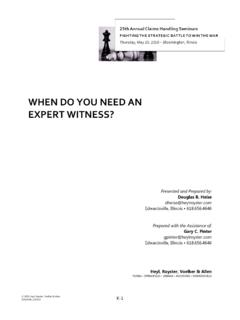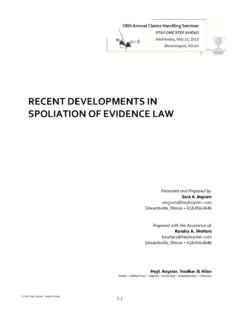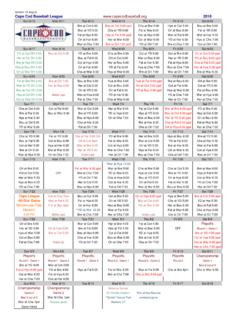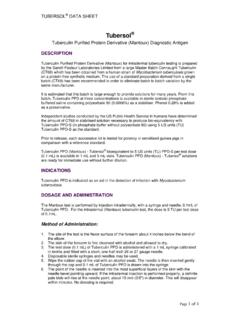Transcription of USE OF AMA IMPAIRMENT RATINGS: SEIZE THE MOMENT …
1 C-1 USE OF AMA IMPAIRMENT ratings : SEIZE THE MOMENT TO REDUCE PPD AWARDS! Presented and Prepared by: Bruce L. Bonds Urbana, Illinois Heyl, Royster, Voelker & Allen PEORIA SPRINGFIELD URBANA ROCKFORD EDWARDSVILLE CHICAGO 2012 Heyl, Royster, Voelker & Allen C-2 USE OF AMA IMPAIRMENT ratings : SEIZE THE MOMENT TO REDUCE PPD AWARDS! I. EVALUATING THE permanent partial disability UNDER THE 2011 AMENDMENTS TO THE ILLINOIS WORKERS COMPENSATION ACT .. C-3 A. What Is the Difference Between disability and IMPAIRMENT ? .. C-4 B. Why Were the AMA Guides Included In the 2011 Amendments? .. C-5 C. Who Can Prepare an AMA Rating Report? .. C-5 D. Can a Treating Physician Perform an AMA Rating? .. C-5 E. Can/Should the Workers Compensation Insurance Carrier or Plaintiff s Attorney Request an AMA Rating From the Treating Physician (Where They Are Qualified to Render One)?
2 C-6 F. Admissibility of AMA ratings .. C-6 G. Can a Physician Performing an IME Pursuant to Section 12 of the WC Act Provide an AMA Rating? .. C-7 H. How Much Does an AMA Rating Cost? .. C-7 I. When Is It Appropriate to Obtain an AMA Rating? .. C-7 J. Can AMA Guides Be Used to Establish Work Restrictions? .. C-7 II. HOW ARE AMA IMPAIRMENT ratings DETERMINED? .. C-8 A. Diagnosis: .. C-8 B. Modifiers: .. C-8 C. What Are Typical AMA ratings for Common Workers Compensation Injuries? .. C-9 D. Conversions .. C-9 E. Anomalies Between Illinois Workers Compensation Law and the AMA Guides? .. C-10 III. IS SUBMISSION OF AN IMPAIRMENT RATING INTO EVIDENCE REQUIRED BEFORE AN ARBITRATOR CAN AWARD PPD BENEFITS? .. C-10 A. Statutory Requirement .. C-10 B. IWCC Interpretations (or It Depends on the Definition of What Is Is!)
3 C-11 C. Practical Considerations and Petitioners Anticipated Strategies .. C-11 IV. LET S CREATE THE NEW Q-DEX: HOW TO SEIZE THE MOMENT TO REDUCE PPD AWARDS! .. C-12 The cases and materials presented here are in summary and outline form. To be certain of their applicability and use for specific claims, we recommend the entire opinions and statutes be read and counsel consulted. C-3 USE OF AMA IMPAIRMENT ratings : SEIZE THE MOMENT TO REDUCE PPD AWARDS! I. EVALUATING THE permanent partial disability UNDER THE 2011 AMENDMENTS TO THE ILLINOIS WORKERS COMPENSATION ACT The 2011 amendments changed the criteria for evaluating permanent partial disability for injuries that occur on or after September 1, 2011. Pursuant to 820 ILCS 305 (b), permanent partial disability for accidental injuries that occurred on or after that date shall be established using the following criteria: (a) A physician licensed to practice medicine in all of its branches preparing a permanent partial disability IMPAIRMENT report shall report the level of IMPAIRMENT in writing.
4 The report shall include an evaluation of medically defined and professionally appropriate measurements of IMPAIRMENT that include, but are not limited to: loss of range of motion; loss of strength; measured atrophy of tissue mass consistent with the injury; and any other measurements that establish the nature and extent of the IMPAIRMENT . The most current edition of the American Medical Association s Guides to the Evaluation of permanent IMPAIRMENT shall be used by the physician in determining the level of IMPAIRMENT . (b) In determining the level of permanent partial disability , the Commission shall base its determination on the following factors: (i) the reported level of IMPAIRMENT pursuant to subsection (a) ( ; the AMA rating) (ii) the occupation of the injured employee (iii) the age of the employee at the time of the injury (iv) the employee s future earning capacity (v) evidence of disability corroborated by the treating medical records.
5 No single enumerated factor shall be the sole determinant of disability . In determining the level of disability , the relevance and weight of any factors used in addition to the level of IMPAIRMENT as reported by the physician must be explained in a written order. 820 ILCS 305 C-4 A. What Is the Difference Between disability and IMPAIRMENT ? It is important to differentiate between the concepts of disability and IMPAIRMENT . The AMA Guides to the Evaluation of permanent IMPAIRMENT , Sixth Edition (the second printing of which is the most recent edition) indicates that: 1. IMPAIRMENT is a significant deviation, or loss of use of any body structure or body function in an individual with a health condition, disorder, or disease. 2. disability has been defined as activity limitations and/or participation restrictions in an individual with a health condition, disorder, or disease.
6 3. IMPAIRMENT rating has been defined as a consensus-derived percentage estimate of loss of activity reflecting severity for a given health condition, and the degree of associated limitations in terms of activities of daily living ( ADL s ). 4. ADL s Basic self-care activities performed in one s personal life such as feeding, bathing, hygiene and dressing. IMPAIRMENT and disability as used in the 2011 amendments are separate concepts. The AMA IMPAIRMENT rating is a component of the PPD percentage loss of use assessment, but there is not an equal sign between the IMPAIRMENT rating and PPD. Example: Both a lawyer and a pianist sustain an amputation of the non-dominant little finger. Both have the same IMPAIRMENT under the AMA Guides: 100% of the digit, 10% of the hand, 9% of the upper extremity or 5% of the whole person.
7 The lawyer has no disability . The pianist is unable to perform his/her occupation and is therefore totally disabled from his occupation, although fully capable of many other jobs. The AMA Guides Sixth Edition clearly indicates that disability (or PPD) is a determination made by an administrative law judge and may or may not have a relationship to an IMPAIRMENT . All editions of the AMA Guides state that an IMPAIRMENT rating is not equal to a disability rating and is not intended to be a measure of disability since disability has to do with limitations or restrictions in job functions rather than the actual anatomic limitation. Nonetheless the fact that an AMA IMPAIRMENT rating will usually be significantly lower than the customary PPD award for the same injury should, if properly presented by knowledgeable counsel, reduce PPD awards going forward.
8 All players in the WC system, including the Chairman of the IWCC and the most rabid plaintiffs attorneys, acknowledge this and anticipate lower PPD awards. C-5 B. Why Were the AMA Guides Included In the 2011 Amendments? 1. To provide greater uniformity in PPD awards. 2. To reduce the value of awards as AMA ratings are typically much lower than the typical PPD award for the same injury. C. Who Can Prepare an AMA Rating Report? 1. Section (b) of the Act requires that the report be prepared by a physician licensed to practice medicine in all of its branches. Thus, in Illinois, non-physicians such as chiropractors are not permitted to provide IMPAIRMENT ratings . The Act does not, however, require that the physician be certified to perform an AMA rating. Note that the AMA Guidelines themselves do permit IMPAIRMENT evaluations from medical doctors who are qualified in allopathic or osteopathic medicine or chiropractic medicine.
9 The Guides also permit non-physician evaluators to analyze an IMPAIRMENT evaluation to determine if it was performed in accordance with the Guides. This will not be the case in Illinois pursuant to the 2011 amendments. 2. Presumably an IMPAIRMENT rating by a certified physician will carry more weight than one by a non-certified individual, although the certification is not required by either the AMA Guides or the Illinois statute. A physician can obtain certification by attending a two-day class which costs between $800 - $1,000. D. Can a Treating Physician Perform an AMA Rating? 1. An AMA IMPAIRMENT rating is customarily provided by treating physicians in other jurisdictions, including our nearby neighbor Indiana where the treating physician who is chosen by the employer may use AMA Guidelines to determine the injured worker s permanency.
10 2. The Guides themselves indicate that treating doctors should not be doing AMA IMPAIRMENT ratings as they are not independent, and therefore, their determinations may be subject to greater scrutiny, because they are considered biased in favor of the patient. The AMA Guides emphasize that the physician s role in performing an IMPAIRMENT evaluation is to provide an independent unbiased assessment of the individual s medical condition, including its effect on function and of limitations to the performance of Activities of Daily Living. The Guides explicit acknowledgment of the bias of treating physicians in favor of their patients brings a refreshing dose of common sense to a workers compensation system which has traditionally accorded greater weight to medical opinions expressed by an injured employee s treating physician, including issues of causal connection, work restrictions and the need for medical treatment.







